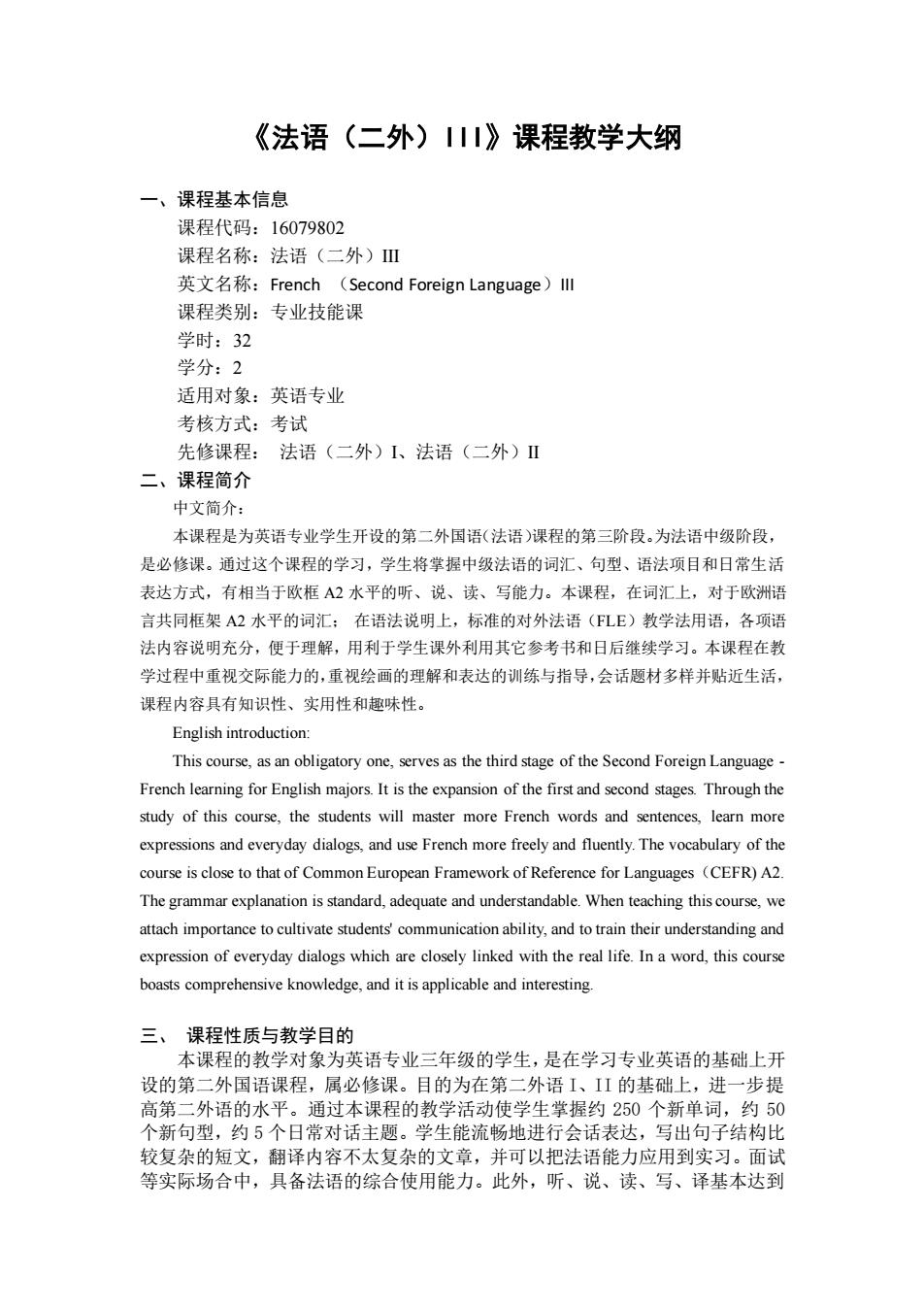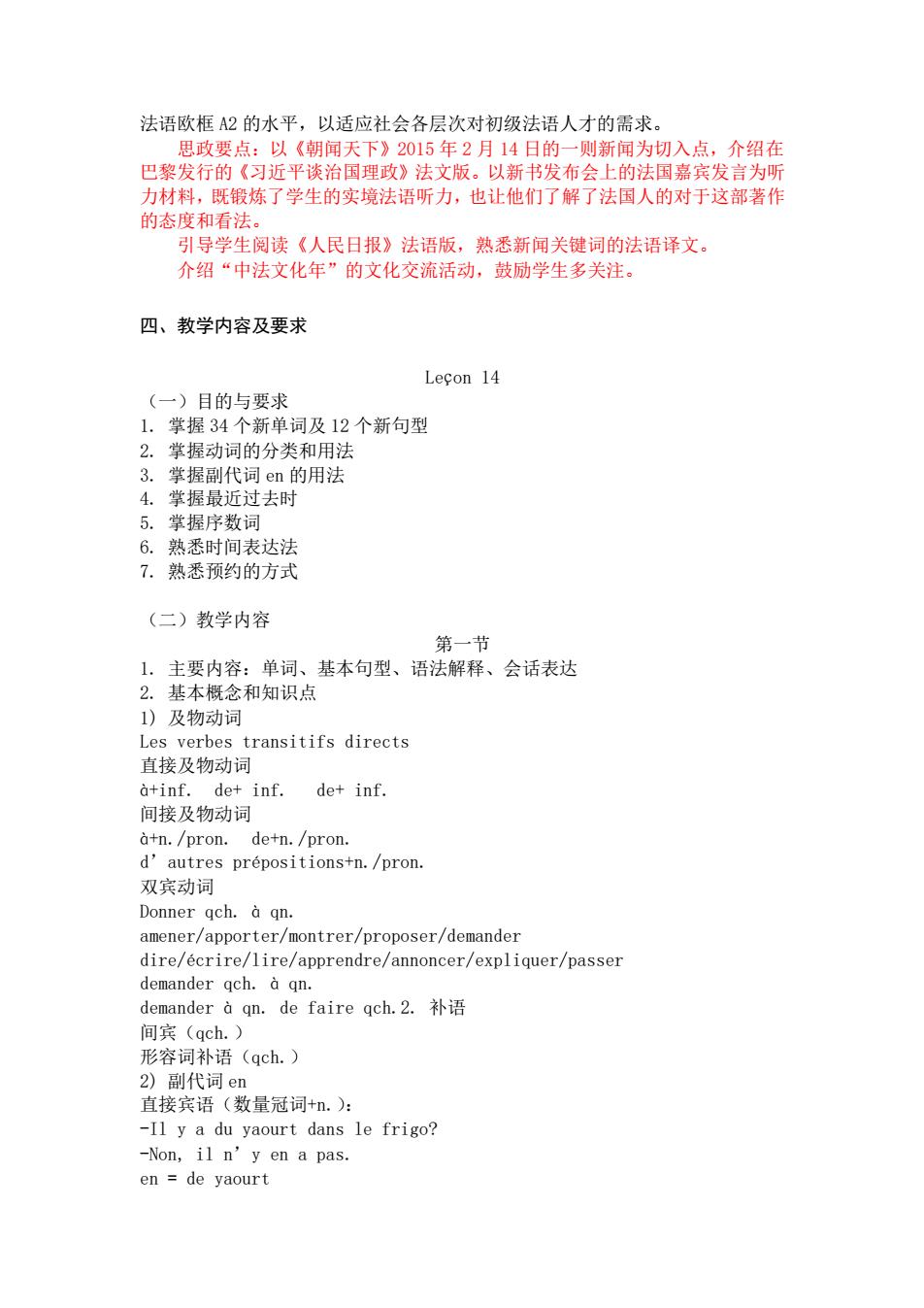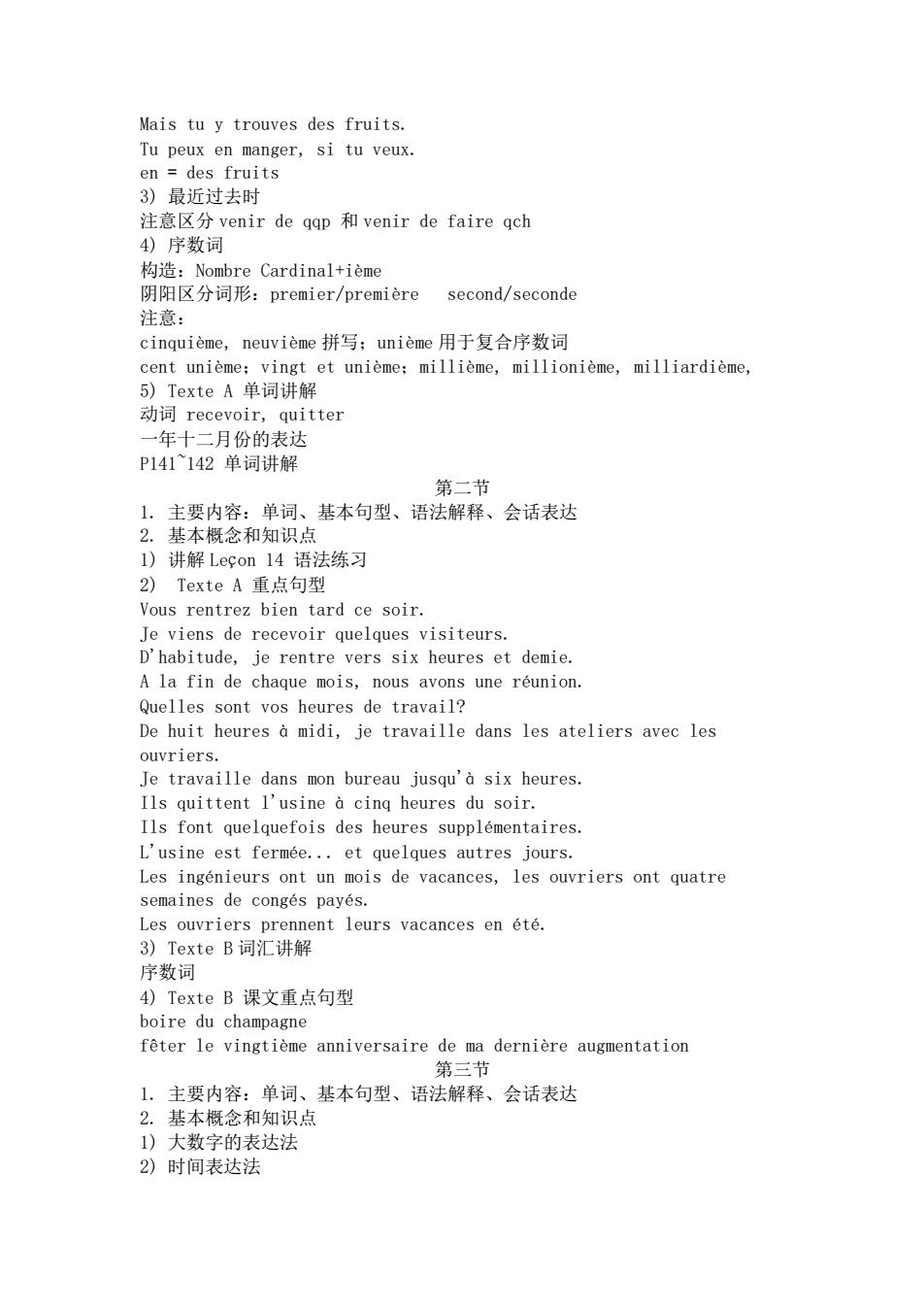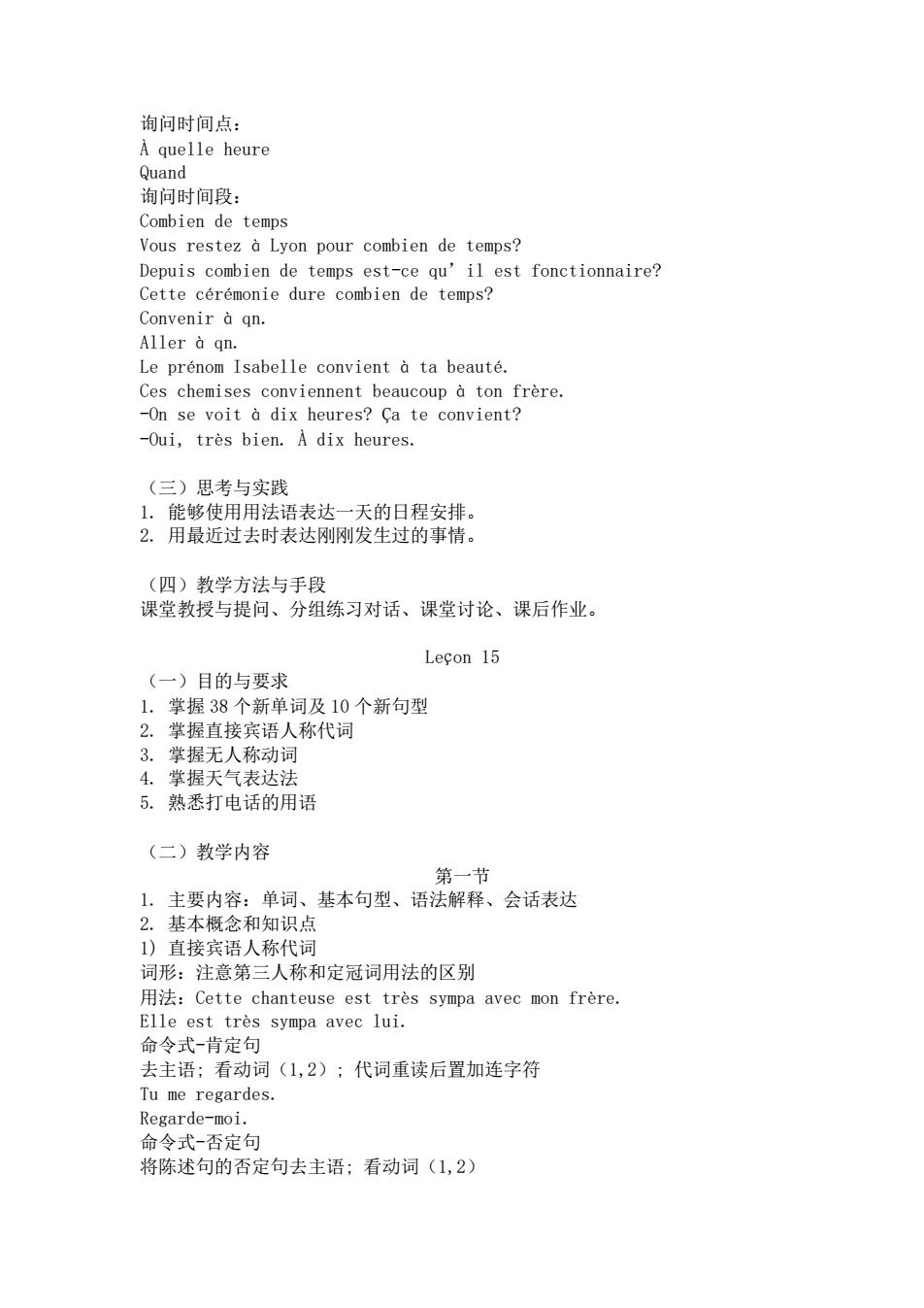
《法语(二外)11》课程教学大纲 一、课程基本信息 课程代码:16079802 课程名称:法语(二外)Ⅲ 英文名称:French(Second Foreign Language)川 课程类别:专业技能课 学时:32 学分:2 适用对象:英语专业 考核方式:考试 先修课程:法语(二外)【、法语(二外)Ⅱ 二、课程简介 中文简介: 本课程是为英语专业学生开设的第二外国语(法语)课程的第三阶段为法语中级阶段 是必修课。通过这个课程的学习,学生将掌握中级法语的词汇、句型、语法项目和日常生活 表达方式,有相当于欧框A2水平的听、说、读、写能力。本课程,在词汇上,对于欧洲语 言共同框架A2水平的词汇:在语法说明上,标准的对外法语(LE)教学法用语,各项语 法内容说明充分,便于理解,用利于学生课外利用其它参考书和日后继续学习。本课程在教 学过程中重视交际能力的,重视绘画的理解和表达的训练与指导,会话题材多样并贴近生活, 课程内容具有知识性、实用性和趣味性。 English introduction This course,as an obligatory one,serves as the third stage of the Second Foreign Language French learning for English majors.It is the expansion of the first and second stages.Through the study of this couse,the students will master more French words and sentences,learn more expressions and everyday dialogs,and use French more freely and fluently.The vocabulary of the course is close to that of Common European Framework of Reference for Languages (CEFR)A2 The grammar explanation is standard.adequate and understandable.When teaching this course.we attach importance,and torain their understanding and expression of everyday dialogs which are closely linked with the real life.In a word.this course boasts comprehensive knowledge,and it is applicable and interesting. 三、课程性质与教学目的 本课程的教学对象为英语专业三年级的学生,是在学习专业英语的基础上开 设的第二外国语课程,属必修课。目的为在第二外语I、IⅡ的基础上 ,进一步损 高第二外语的水平。通过本课程的教学活动使学生掌握约250个新单词,约50 个新句型,约5个日常对话主题。学生能流畅地进行会话表达,写出句子结构比 较复杂的短文,翻译内容不太复杂的文章,并可以把法语能力应用到实习。面试 等实际场合中,具备法语的综合使用能力。此外,听、说、读、写、译基本达到
《法语(二外)III》课程教学大纲 一、课程基本信息 课程代码:16079802 课程名称:法语(二外)III 英文名称:French (Second Foreign Language)III 课程类别:专业技能课 学时:32 学分:2 适用对象:英语专业 考核方式:考试 先修课程: 法语(二外)I、法语(二外)II 二、课程简介 中文简介: 本课程是为英语专业学生开设的第二外国语(法语)课程的第三阶段。为法语中级阶段, 是必修课。通过这个课程的学习,学生将掌握中级法语的词汇、句型、语法项目和日常生活 表达方式,有相当于欧框 A2 水平的听、说、读、写能力。本课程,在词汇上,对于欧洲语 言共同框架 A2 水平的词汇; 在语法说明上,标准的对外法语(FLE)教学法用语,各项语 法内容说明充分,便于理解,用利于学生课外利用其它参考书和日后继续学习。本课程在教 学过程中重视交际能力的,重视绘画的理解和表达的训练与指导,会话题材多样并贴近生活, 课程内容具有知识性、实用性和趣味性。 English introduction: This course, as an obligatory one, serves as the third stage of the Second Foreign Language - French learning for English majors. It is the expansion of the first and second stages. Through the study of this course, the students will master more French words and sentences, learn more expressions and everyday dialogs, and use French more freely and fluently. The vocabulary of the course is close to that of Common European Framework of Reference for Languages(CEFR) A2. The grammar explanation is standard, adequate and understandable. When teaching this course, we attach importance to cultivate students' communication ability, and to train their understanding and expression of everyday dialogs which are closely linked with the real life. In a word, this course boasts comprehensive knowledge, and it is applicable and interesting. 三、 课程性质与教学目的 本课程的教学对象为英语专业三年级的学生,是在学习专业英语的基础上开 设的第二外国语课程,属必修课。目的为在第二外语 I、II 的基础上,进一步提 高第二外语的水平。通过本课程的教学活动使学生掌握约 250 个新单词,约 50 个新句型,约 5 个日常对话主题。学生能流畅地进行会话表达,写出句子结构比 较复杂的短文,翻译内容不太复杂的文章,并可以把法语能力应用到实习。面试 等实际场合中,具备法语的综合使用能力。此外,听、说、读、写、译基本达到

法语欧框2的水平,以适应社会各层次对初级法语人才的需求。 思政要点:以《朝闻天下》2015年2月14日的一则新闻为切入点,介绍在 巴黎发行的《习近平谈治国理政》法文版。 以新书发布会上的法国嘉宾发 力材料,既锻炼了学生的实境法语听力,也让他们了解了法国人的对于这部著作 的态度和看法。 引导学生阅读《人民日报》法语版,熟悉新闻关键词的法语译文。 介绍“中法文化年”的文化交流活动,鼓励学生多关注。 四、教学内容及要求 Lecon 14 (一·)目的与要求 掌握动词的分类和用法 掌握副代词en的用法 4.掌握最近过去时 5.掌握序数词 6.熟悉时间表达法 7.熟悉预约的方式 (二)教学内容 第一节 1.主要内容:单词、基本句型、语法解释、会话表达 2.基本概念和知识点 1)及物动词 Les verbes transitifs directs 直接及物动词 a+inf.de+inf.de+inf 间接及物动词 aniTgrsitosnoe de+n./pron 双宾动词 Donner ach.a an eapprendre/amoncer/expliquer/passe proposer/demander dire/ecrire demander qch.a qn. demander a qn..de faire qch..2.补语 间宾(qch.) 形容词补语(gch.) 2)副代词 直接宾语(数量冠词+n.): -I1 y a du yaourt dans le frigo? -Non,il n'y en a pas. en de yaourt
法语欧框 A2 的水平,以适应社会各层次对初级法语人才的需求。 思政要点:以《朝闻天下》2015 年 2 月 14 日的一则新闻为切入点,介绍在 巴黎发行的《习近平谈治国理政》法文版。以新书发布会上的法国嘉宾发言为听 力材料,既锻炼了学生的实境法语听力,也让他们了解了法国人的对于这部著作 的态度和看法。 引导学生阅读《人民日报》法语版,熟悉新闻关键词的法语译文。 介绍“中法文化年”的文化交流活动,鼓励学生多关注。 四、教学内容及要求 Leçon 14 (一)目的与要求 1. 掌握 34 个新单词及 12 个新句型 2. 掌握动词的分类和用法 3. 掌握副代词 en 的用法 4. 掌握最近过去时 5. 掌握序数词 6. 熟悉时间表达法 7. 熟悉预约的方式 (二)教学内容 第一节 1. 主要内容:单词、基本句型、语法解释、会话表达 2. 基本概念和知识点 1) 及物动词 Les verbes transitifs directs 直接及物动词 à+inf. de+ inf. de+ inf. 间接及物动词 à+n./pron. de+n./pron. d’autres prépositions+n./pron. 双宾动词 Donner qch. à qn. amener/apporter/montrer/proposer/demander dire/écrire/lire/apprendre/annoncer/expliquer/passer demander qch. à qn. demander à qn. de faire qch.2. 补语 间宾(qch.) 形容词补语(qch.) 2) 副代词 en 直接宾语(数量冠词+n.): -Il y a du yaourt dans le frigo? -Non, il n’y en a pas. en = de yaourt

Mais tu y trouves des fruits. Tu pouorngersi tu voux 注意区分venir de qap和venir de faire qch 4)序数词 构诰:Nombre cardinal+iem 阴阳区分词形:premier/,premiere second/seconde 注意: cinquieme,neuvieme拼写;unieme用于复合序数词 cent unieme:vingt et unieme:millieme,millionieme,milliardieme, 5)Texte A单词讲解 动词recevoir,quitter 年十二月份的表达 P141142单词讲解 第二节 1.主要内容:单词、基本句型、语法解释、会话表达 2.基本概念和知识点 1)讲解Lecon14语法练习 2) Texte A重点句型 Vous rentrez bien tard ce soir. Je viens de recevoir quelques visiteurs. D'habitude,je rentre vers six heures et demie. A la fin de chaque mois,nous avons une reunion Quelles sont vos heures de travail? De huit heures a midi,je travaille dans les ateliers avec les ouyriers. Je travaille dans mon bureau jusqu'd six heures. Ils quittent I'usine a cinq heures du soir. Ils font quelquefois des heures supplementaires L usine est fermee...et quelques autres jours. Les ingenieurs ont un mois de vacances.les ouvriers ont quatre semaines de conges payes. Les ouyriers prennent leurs vacances en ete 3)Texte B词汇讲解 序数词 4)Texte B课文重点句型 boire du champagne feter le vingtieme anniversaire de ma derniere augmentation 笋二节 1.主要内容:单词、基本句型、语法解释、会话表达 基本概念和知识点 1)大数字的表达法 2)时间表达法
Mais tu y trouves des fruits. Tu peux en manger, si tu veux. en = des fruits 3) 最近过去时 注意区分 venir de qqp 和 venir de faire qch 4) 序数词 构造:Nombre Cardinal+ième 阴阳区分词形:premier/première second/seconde 注意: cinquième, neuvième 拼写;unième 用于复合序数词 cent unième;vingt et unième;millième, millionième, milliardième, 5) Texte A 单词讲解 动词 recevoir, quitter 一年十二月份的表达 P141~142 单词讲解 第二节 1. 主要内容:单词、基本句型、语法解释、会话表达 2. 基本概念和知识点 1) 讲解 Leçon 14 语法练习 2) Texte A 重点句型 Vous rentrez bien tard ce soir. Je viens de recevoir quelques visiteurs. D'habitude, je rentre vers six heures et demie. A la fin de chaque mois, nous avons une réunion. Quelles sont vos heures de travail? De huit heures à midi, je travaille dans les ateliers avec les ouvriers. Je travaille dans mon bureau jusqu'à six heures. Ils quittent l'usine à cinq heures du soir. Ils font quelquefois des heures supplémentaires. L'usine est fermée... et quelques autres jours. Les ingénieurs ont un mois de vacances, les ouvriers ont quatre semaines de congés payés. Les ouvriers prennent leurs vacances en été. 3) Texte B 词汇讲解 序数词 4) Texte B 课文重点句型 boire du champagne fêter le vingtième anniversaire de ma dernière augmentation 第三节 1. 主要内容:单词、基本句型、语法解释、会话表达 2. 基本概念和知识点 1) 大数字的表达法 2) 时间表达法

询问时间点: quele heure 询问时间段: Combien de temps Vous restez a Lyon pour combien de temps? Convenir a qn Aller a an. le prenom isabelle convient a ta heaute Ces chemises conviennent beaucoup a ton frere -On se voit a dix heures?Ca te convient? -Oui,tres bien.A dix heures. (三)思考与实践 1.能够使用用法语表达一天的日程安排。 2.用最近过去时表达刚刚发生过的事情」 (四)教学方法与手段 课堂教授与提问、分组练习对话、课堂讨论、课后作业。 Lecon 15 ()日的与要求 掌握38 个新单词及10个新句型 2.事握直接宾语人称代面 3.掌握无人称动词 4.掌握天气表达法 5.熟悉打电话的用语 (二)教学内容 第一节 1,主要内容:单词、基本句型、语法解释、会话表达 2.基本概今和知识点 )直接宦人称代司 词形:注意第三人称和定冠词用法的区别 用法:Cette chanteuse est tres sympa avec mon frere. Elle est tres sympa avec lui. 命今式一肯定句 去主语;看动词(1,2);代词重读后置加连字符 Tu me regardes Regarde-moi. 命令式-否定句 将陈述句的否定句去主语:看动词(1,2)
询问时间点: À quelle heure Quand 询问时间段: Combien de temps Vous restez à Lyon pour combien de temps? Depuis combien de temps est-ce qu’il est fonctionnaire? Cette cérémonie dure combien de temps? Convenir à qn. Aller à qn. Le prénom Isabelle convient à ta beauté. Ces chemises conviennent beaucoup à ton frère. -On se voit à dix heures? Ça te convient? -Oui, très bien. À dix heures. (三)思考与实践 1. 能够使用用法语表达一天的日程安排。 2. 用最近过去时表达刚刚发生过的事情。 (四)教学方法与手段 课堂教授与提问、分组练习对话、课堂讨论、课后作业。 Leçon 15 (一)目的与要求 1. 掌握 38 个新单词及 10 个新句型 2. 掌握直接宾语人称代词 3. 掌握无人称动词 4. 掌握天气表达法 5. 熟悉打电话的用语 (二)教学内容 第一节 1. 主要内容:单词、基本句型、语法解释、会话表达 2. 基本概念和知识点 1) 直接宾语人称代词 词形:注意第三人称和定冠词用法的区别 用法:Cette chanteuse est très sympa avec mon frère. Elle est très sympa avec lui. 命令式-肯定句 去主语; 看动词(1,2); 代词重读后置加连字符 Tu me regardes. Regarde-moi. 命令式-否定句 将陈述句的否定句去主语; 看动词(1,2)

Tu ne me regardes pas. Ne me regarde pas. 2)无人称动词 主语:中性代词 动词变位:3单 绝对无人称动词falloir 装”外可以老用为人动词 天气表达 temps ensoleille -soleil temps nuageux →nuage temps orageux -orage temps venteux +vent→venter temps neigeux →neige→neiger temps pluvieux I1ya+数量冠词+名词表示天气 des nuages,de la pluie,de la neige,de 1'orage,du vent,du soleil FAIRE表示天气 Il fait beau/mauvais. Il fait chaud/froid I1 fait humide/sec.潮湿/干燥 Il fait un temps de chien.天气糟糕 Il fait un temps magnifique.天气很棒 Il fait du soleil/de la lune/du vent.(Ilya…) 4)单词讲解 动词变位:croire动词用法:P153154 第■节 1.主要内容:单词、基本句型、语法解释、会话表达 2,基本概念和知识点 )Texte A的课文重要句型 Tu m'entends? Tu telephones du camping? Quel temps fait-i1? Trente degres aujourd'hui. J'ai tres chaud. Vous restez encore quelque temps la-bas? faire la promenade,nager dans la mer,pique-niquer. 2)Texte B的重点单词和句型 Il n'a plus une minute a perdre Au moment de quitter I'hotel,il s'adresse au garcon Trois mi apres egarcon revient et repond,tout essouffle 3)直接疑问句和间接疑问句 第三节 1.主要内容:单词、基本句型、语法解释、会话表达
Tu ne me regardes pas. Ne me regarde pas. 2) 无人称动词 主语:中性代词 il 动词变位:3 单 绝对无人称动词 falloir Il faut faire qch. 3) 气象动词(部分可以兼用为人称动词) 天气表达 temps ensoleillé →soleil temps nuageux →nuage temps orageux →orage temps venteux →vent →venter temps neigeux →neige →neiger temps pluvieux Il y a+数量冠词+名词 表示天气 des nuages, de la pluie, de la neige, de l’orage, du vent, du soleil FAIRE 表示天气 Il fait beau/mauvais. Il fait chaud/froid. Il fait humide/sec.潮湿/干燥 Il fait un temps de chien. 天气糟糕 Il fait un temps magnifique.天气很棒 Il fait du soleil/de la lune/du vent.(Il y a…) 4) 单词讲解 动词变位:croire 动词用法: P153~154 第二节 1. 主要内容:单词、基本句型、语法解释、会话表达 2. 基本概念和知识点 1) Texte A 的课文重要句型 Tu m'entends? Tu téléphones du camping? Quel temps fait-il? Trente degrés aujourd'hui. J'ai très chaud. Vous restez encore quelque temps là-bas? faire la promenade, nager dans la mer, pique-niquer. 2) Texte B 的重点单词和句型 Il n'a plus une minute à perdre. Au moment de quitter l'hôtel, il s'adresse au garçon Trois minutes après, le garçon revient et répond, tout essoufflé 3) 直接疑问句和间接疑问句 第三节 1. 主要内容:单词、基本句型、语法解释、会话表达